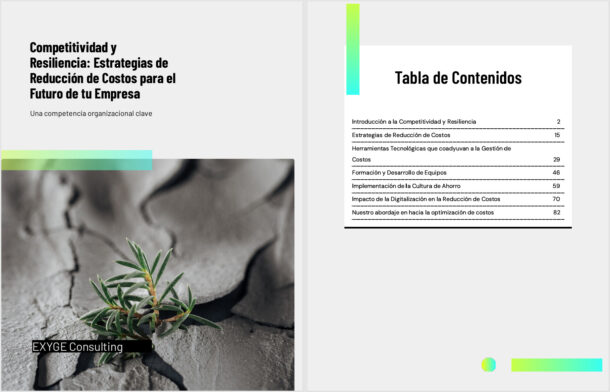We all hate cutting costs…. but it is essential for resilience and sustainability
by Otto Acuña N – Managing Director – EXYGE Consulting – January 2025
The economic and business landscape in many regions of the World, including Latin America, the Caribbean and the GCC Region in the Middle East, require organizations to adopt more sophisticated and structured strategies to meet the challenges of moderate growth and an extremely uncertain environment. 3% to 5% of growth in these markets is not bad, but the geopolitics of each region can change this situation drastically. In this context, cost reduction is not only an operational necessity, but also a key strategic lever to ensure sustainability and long-term growth. In a previous article, almost 5 years ago in NearshoreAmericas I stated that “everyone hates cutting costs, but it’s something you have to do right…..” and this statement is still true in 2025.
This note in the CEO Perspectives series presents an expanded framework for approaching cost reduction, not as an emergency measure, but as a comprehensive and well-planned process, part of the strategy to achieve resilience to the unforeseen, that boosts competitiveness, aligns strategic objectives, and protects organizational culture.

The Economic Context and the Need to Adapt
Moderate economic growth
Latin America remains stuck in a low-growth trap, projecting limited economic growth of 2.4% by 2025, the Caribbean region is not far at 2.5%. The GCC Region has been somewhat insulated economically, with a projected growth of 4% for 2025; nevertheless the geopolitical turmoil the region is in makes difficult to plan for the long term. With respect to the US, it is currently a wild guess in many respects. In such an environment where many different factors may affect how this year will turnout, companies need to be smarter when allocating their resources.
Geopolitical and social challenges
Political instability and polarization in the region, along with external factors such as tensions between global powers and the fragmentation of trade, increase volatility and risk for businesses. This forces organizations to maintain agile, proactive and resilient management.
Emerging opportunities
Sectors such as nearshoring, specialized services, and advances in affordable technology presentopportunities for diversification and growth, but require strategically redistributed resources. Reducing costs should not mean sacrificing key opportunities, but freeing up capital to take advantage of them.
Fundamental Principles for Successful Cost Reduction
1. Deep analysis of the cost balance
The first step is a detailed mapping of the company’s cost structure. This involves:
- Analyze annual spending to identify the main cost categories and their “drivers” or elements that “generate the cost.”
- Understanding current contracts and supplier relationships: which ones can be renegotiated or adjusted?
- Identify recurring costs in subscriptions, especially cloud services, and analyze their current utilization, areas of overlap, and opportunities to optimize infrastructure without major impact on operational capacity.
- Identify areas of disproportionate spend versus the value delivered.
This analysis not only reveals priority areas for reduction, but also opportunities to optimize processes and restructure the operation.
2. Prioritize the essentials with the minimum viable business model
Determine which processes and activities are indispensable to deliver value to the customer. Classify the following:
- Essentials: Directly linked to the core value proposition that the business provides and what its customers appreciate.
- Important items: They add value, but they could be adjusted without much notice by the customer or without significantly affecting the company’s ability to operate.
- Accessory items: Dispensable, secondary or redundant. Pay close attention to payments for cloud applications, as platforms have evolved greatly in their functionalities and over time they could have overlaps or redundant services that are dispensable.
The goal is to ensure that reduction decisions protect critical areas of the operation while optimizing resources for lower-impact activities.
3. Act strategically
Instead of applying horizontal cuts or “across the board” (which rarely work), focus on potential reductions on the 70% or 80% of spending that usually are the highest cost items. Carefully reduce in areas that, although costly, do not negatively impact the essential operation.
4. Agile but rigorous implementation
The process should not be prolonged indefinitely, since uncertainty and the emotional effects of the initiative on the work environment and organizational culture will begin to affect the operational capacity, the reputation of the company and other negative effects.
The first phases of analysis, prioritization and planning should be completed within a maximum of 6-8 weeks. This ensures that measures are implemented before cumulative costs pose a greater threat. Ideally, the changes should be implemented quickly enough that their effect can be seen in the same fiscal year
Too many prolonged changes (or the perception of prolonged changes) has a burn-out effect that can be devastating on your staff if left unchecked.
If there are medium- and long-term measures that can extend the process beyond a year, it is advisable to segment the plan into phases and focus on completing stages, stabilizing changes and reaping the effects of adjustments in a sustainable way. Too many prolonged changes (or the perception that they are prolonged) has a wear and tear effect that can be devastating if left unchecked.
Expanding the Process: Communication, People, and Monitoring
Communication Strategy
An effective communication plan minimizes the cultural and emotional impact of difficult decisions:
- Transparency: Explain the reasons behind the measures clearly and directly.
- Frequency and consistency: Establish a timeline for communicating progress and decisions, avoiding prolonged periods of uncertainty.
- Empathy: Recognize human impact and communicate with respect. Be supportive as much as possible, seeking an implementation of the changes that is perceived as fair and empathetic with those affected and that demonstrates respect for people.
People Management
Employees are a company’s most valuable asset. Even in times of austerity, it is crucial to:
- Reassign talent: Retrain employees into critical or emerging roles within the organization.
- If possible, use natural turnover to decrease the need to dismiss personnel.
- Support transitions: Offer fair exit packages, retraining programs, or connect them with external opportunities (outplacement).
Treating impacted people with respect and solidarity is just as important to them as it is to the people who stay with the organization. A poorly managed transition generates additional turnover that was not planned, potentially generating areas of operational crisis, reputational damage and even impact on customers or suppliers.
Involve your staff in achieving cost reduction goals
If you have been transparent about the actions that need to be taken and your staff perceive the process as fair and logical under difficult circumstances, you may be able to involve staff in initiatives where they can contribute or contribute ideas for improvement. Examples of these programs are:
- Improving internal logistics in peak periods to try to reduce overtime and expenses associated with working late (taxis, dinners and other expenses associated with working outside of normal hours).
- Collect ideas from staff to reduce costs and celebrate small successes
- Make sure that the implementation of staff’s ideas has a beginning, a development and an end, with measurement of results and celebration in case of success, as well as collection of lessons learned if it was not successful (some ideas can be successful and others not so much, but they all contribute a grain of sand to the final goal).
Austerity with clear indicators
Set specific, measurable KPIs to monitor the actual impact of initiatives. Examples:
- Reduce communication costs by 10%.
- Optimize inventories to reduce costs by 15%.
- Implement automation to save 8% in administrative time and resources.
Monitor in detail the progress achieved in obtaining the expected results, cost center by cost center, with some accountability scheme month by month. An example of this type of practice is to have a monthly call with each cost center manager, to see the numbers for the month versus last month, versus the projected budget and the same month last year. By carrying out this exercise in an open and public way, with indicators and identifying trends, understanding deviations from what is expected and adjusting forward, a culture of continuous improvement applied to cost reduction will be achieved.
Avoiding Pitfalls: What Can Go Wrong and How to Prevent It
Cost reduction, if not handled correctly, can bring unintended consequences. Among the main errors are:
- Indiscriminate cuts:
- Problem: Apply horizontal reductions across the board without discriminating between critical and secondary areas.
- Solution: Base decisions on a detailed analysis of costs and their impact.
- Negative impact on morale and organizational culture:
- Problem: A lack of proper communication can lead to mistrust, demotivation, or resistance.
- Solution: Design a clear and empathetic communication plan that keeps employees informed and engaged.
- Loss of key capabilities:
- Problem: Laying off essential staff or reducing strategic activities can compromise the company’s ability to compete.
- Solution: Protect the processes and roles that are indispensable to the company’s value proposition and customer promise.
- Short-term approach:
- Problem: Make decisions that generate immediate savings, but negatively affect competitiveness in the long term.
- Solution: Prioritize sustainable measures that align the cuts with future strategy.
- Apply equal effort and focus to all types of cost reduction:
- Problem: Give equal priority and effort to all cost-cutting initiatives.
- Solution: Select and prioritize the initiatives that will give you “the most savings for your effort.” It is preferable to achieve a 5% reduction in something that represents 50% of expenditure, than to apply the same effort to obtain 50% of something that represents 5% of expenditure.
Where to Start: A Call to Action

Step 1: Assess your current situation
Conduct a thorough financial diagnosis to understand where the greatest weight of your costs lies. If you have the possibility to incorporate an activity-based cost analysis, do so, as it will help guide your efforts to improve your “cost footprint”, also called “run cost”.
Step 2: Define priorities
Identify which areas have the greatest potential for savings with minimal impact on the operation and which critical processes need protection. Perform a risk analysis using a tool that allows you to visualize the consequences of each initiative not working or something going wrong, such as FMEA applied to risk.
Step 3: Form a team
Assign a cross-functional group responsibility for designing, implementing, and monitoring cost-cutting initiatives . This multifunctional group must include not only those who are technically qualified, but also those who give credibility to the process. Remember that the reputation of the cost reduction program is just as important as the proper execution of the program.
Step 4: Design an action plan
Develop a timeline with clear goals, defined deadlines, and specific metrics to evaluate progress. If possible, try to make the dashboard with the KPIs public and updated at least 1 time a month.
Step 5: Engage the organization
Communicate openly with all levels of the organization to ensure alignment and engagement.
The opportunities of our times…. 2025 and beyond
In addition to addressing cost reduction in a technical way, this period represents an opportunity to evaluate the new tools and platforms that can contribute to the success of your initiative:
- Adopt technologies such as automation and advanced analytics that allow shortening their execution times and achieving greater throughput.
- Strengthen organizational resilience by diversifying markets/outputs/inputs/suppliers
- Apply remote or hybrid work schemes, empowered by immersive collaborative technologies, which allow you to lower your cost footprint in terms of physical infrastructure.
- Invest in the sustainability of the measures. The long-term success of your initiative lies in making them the new way of doing things. There are savings that provide a momentary effect but it is known that they will not be maintained. Prioritize measures that can become a new habit, sustainable over time.
Final Thoughts
Cost reduction in 2025-2026 is not simply a survival tactic; it is a strategy to build a more agile, efficient and competitive business. Approaching it from a structured perspective, aligned with strategic objectives and considering human impact will allow companies to not only overcome current challenges, but also thrive in the future.
At EXYGE, we offer specialized advice to design and implement cost reduction programs that maximize your positive impact while mitigating risks. Contact us to explore how we can help you optimize your operation and position yourself for success in a competitive environment.
Additional resources:
- Learn more about our services in Cost Optimization
- Practical Guide on Practical Guide on Cost Reduction for Executives ( Booklet 56 pp) – Register below


